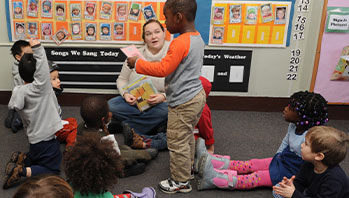- letter squares: e, n, g, i, n, e (one set for each child)
- egg cartons
- letter trays
- The Little Engine That Could (book)
- word card engine (one for each child)
- engine
MA Standards:
English Language Arts/Speaking and Listening/SL.PK.MA.1a: Observe and use appropriate ways of interacting in a group (e.g., taking turns in talking, listening to peers, waiting to speak until another person is finished talking, asking questions and waiting for an answer, gaining the floor in appropriate ways).
English Language Arts/Foundational Skills/RF.PK.MA.3.c: Recognize one’s own name and familiar common signs and labels (e.g., STOP).
Head Start Outcomes:
Social Emotional Development/Self-Regulation: Follows simple rules, routines, and directions.
Language Development/Receptive Language: Attends to language during conversations, songs, stories, or other learning experiences.
Literacy Knowledge/Phonological Awareness: Identifies and discriminates between separate syllables in words.
PreK Learning Guidelines:
English Language Arts/Language 1: Observe and use appropriate ways of interacting in a group (taking turns in talking; listening to peers; waiting until someone is finished; asking questions and waiting for an answer; gaining the floor in appropriate ways).
English Language Arts/Reading and Literature 12: Listen to, recite, sing, and dramatize a variety of age-appropriate literature.
Word Play: Word Engine

© Commonwealth of Massachusetts, Department of Early Education and Care (Jennifer Waddell photographer). All rights reserved.
ELA Focus Skills: Classifying, Comparing and Contrasting, Letter Recognition, Sorting
Educator Prep: Cut full 12-egg cartons in half lengthwise so you have one half of an egg carton (6 egg slots) for each child.
Hold up the book The Little Engine That Could by Watty Piper. Have children share what they know about engines.
- Reinforce that an engine is a big machine with moving parts.
- Explain that it is a strong machine that can pull and push heavy things.
- Have children recall what the engines in the story pushed and pulled.
Now tell children they are going to make their own “word engine.”
- Distribute an egg carton to each child and have him or her place it so the bumps are facing up.
- Point to the word card and have children join you as you count how many letters are in the word engine. (6)
- Then count how many bumps are in each child’s egg carton. (6)
- Tell children they are going to match each letter in the word engine to one of the letter squares. Then they are going to paste the letters in order on the bumps of the egg carton. Be sure to tell children that you will be available to help them place the letters in order on their carton.
Once children have created their word engine, allow time for them to use the engine to push and pull objects (e.g., cubes, paper cups, crayons, etc.) up and down small book ramps.
Adaptation: For groups with children identifying the letters of the alphabet, you may want to have letter squares for all the letters of the alphabet and have children hunt for the letters to build the word engine.
